Semiconductor Device Wherein A First Insulated Gate Field Effect Transistor Is Connected In Series With A Second Field Effect Transistor
Eklund; Klas-Hakan
U.S. patent application number 12/667088 was filed with the patent office on 2010-12-30 for semiconductor device wherein a first insulated gate field effect transistor is connected in series with a second field effect transistor. Invention is credited to Klas-Hakan Eklund.
| Application Number | 20100327330 12/667088 |
| Document ID | / |
| Family ID | 41135815 |
| Filed Date | 2010-12-30 |
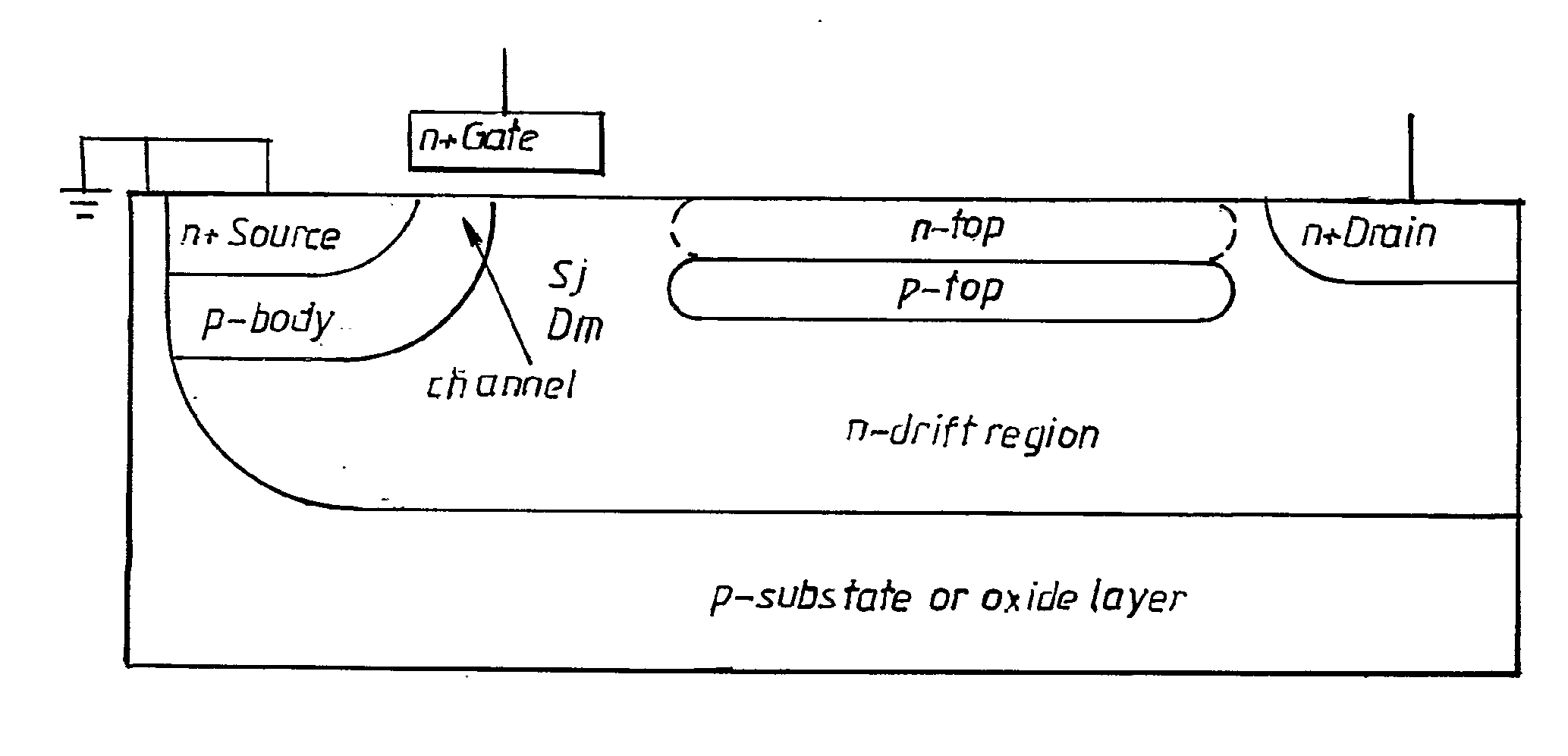
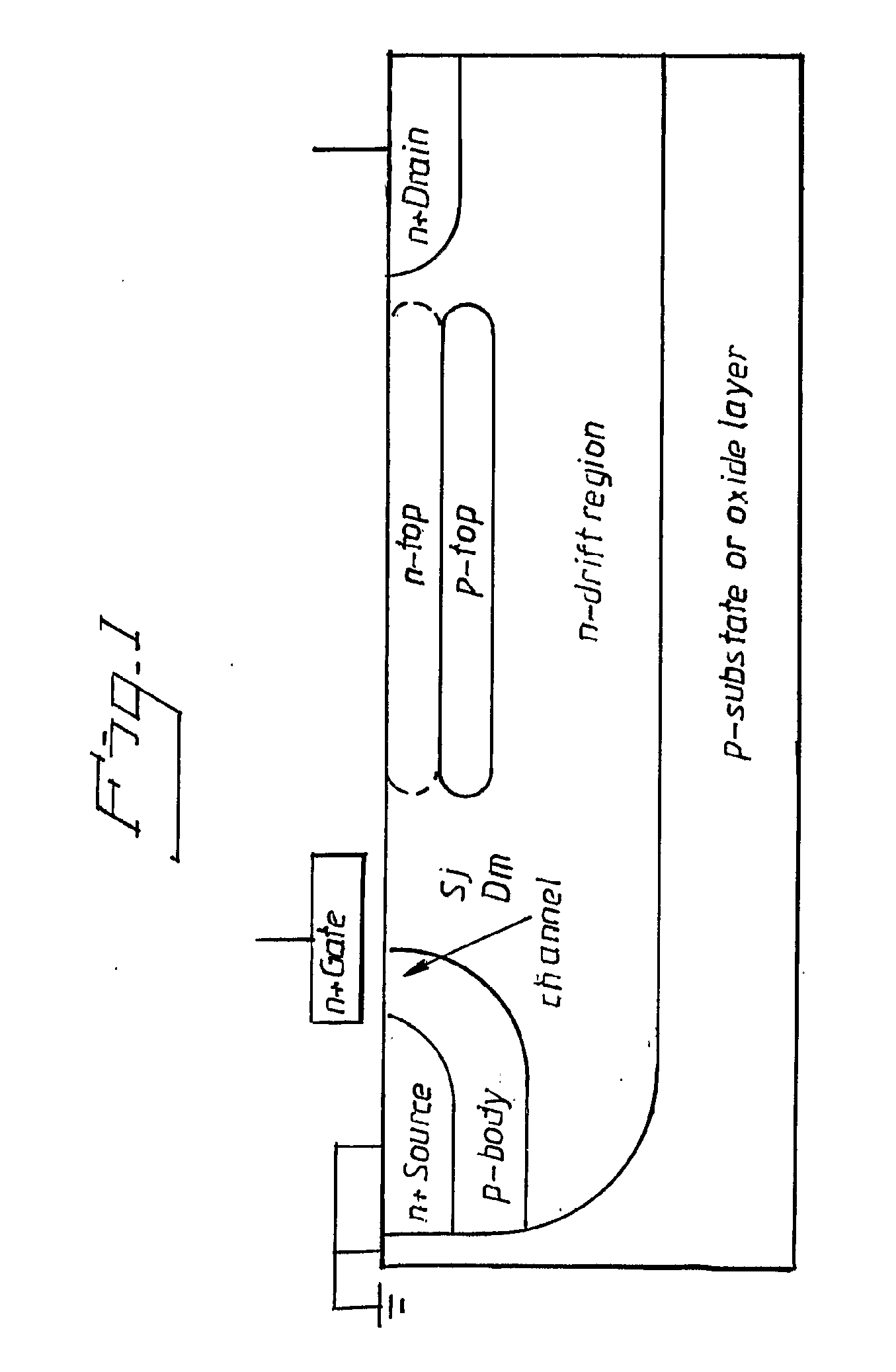
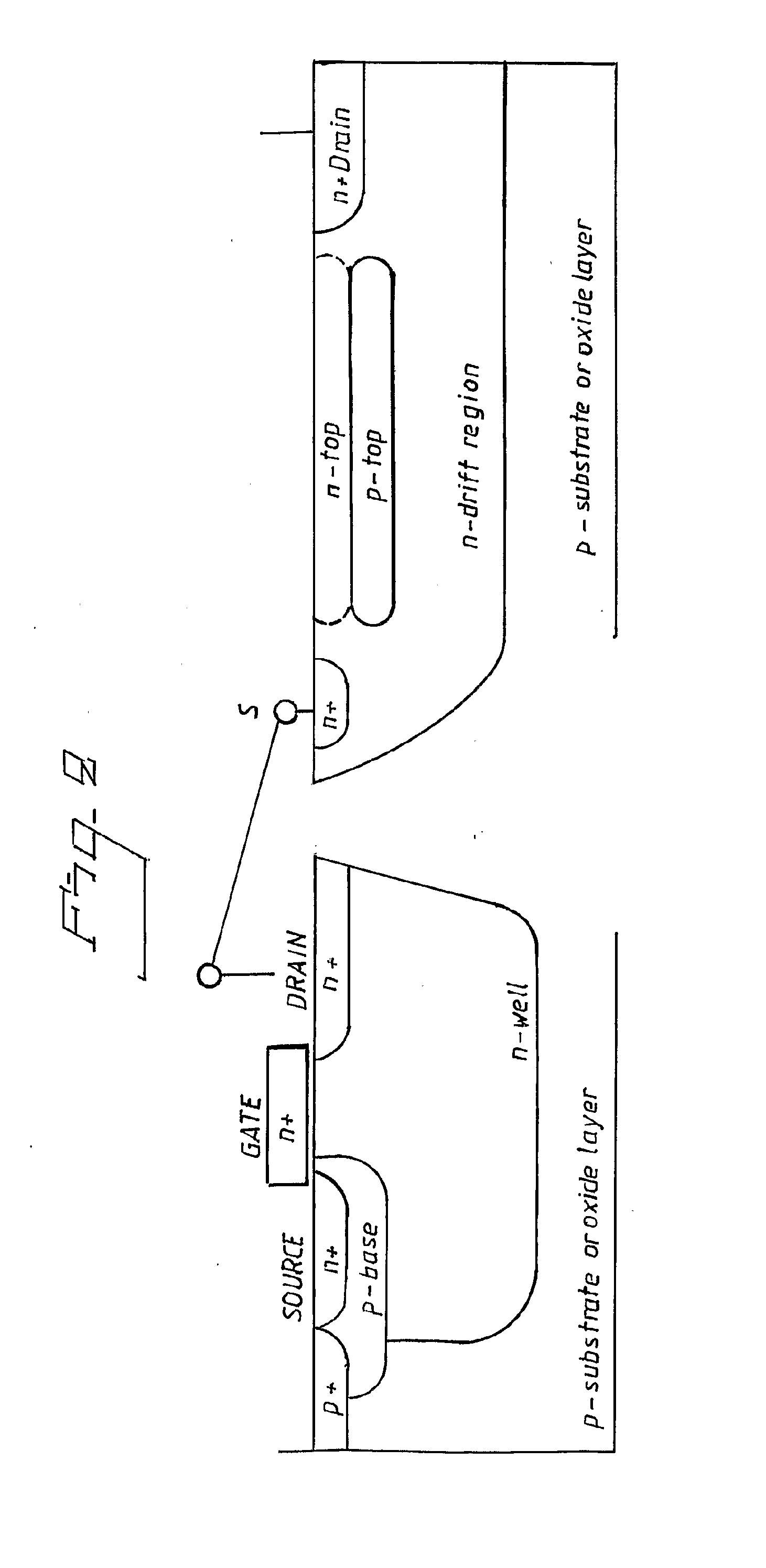
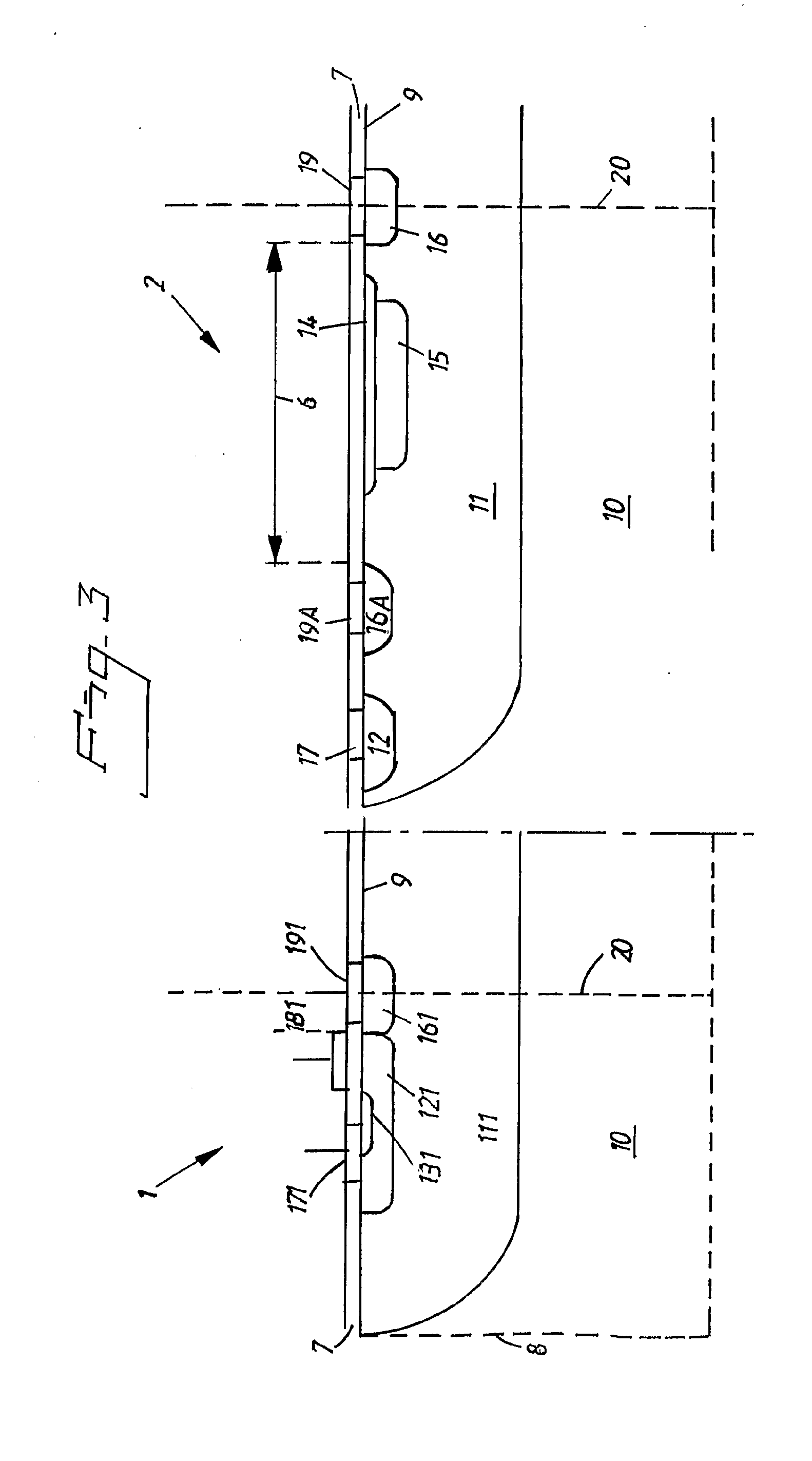
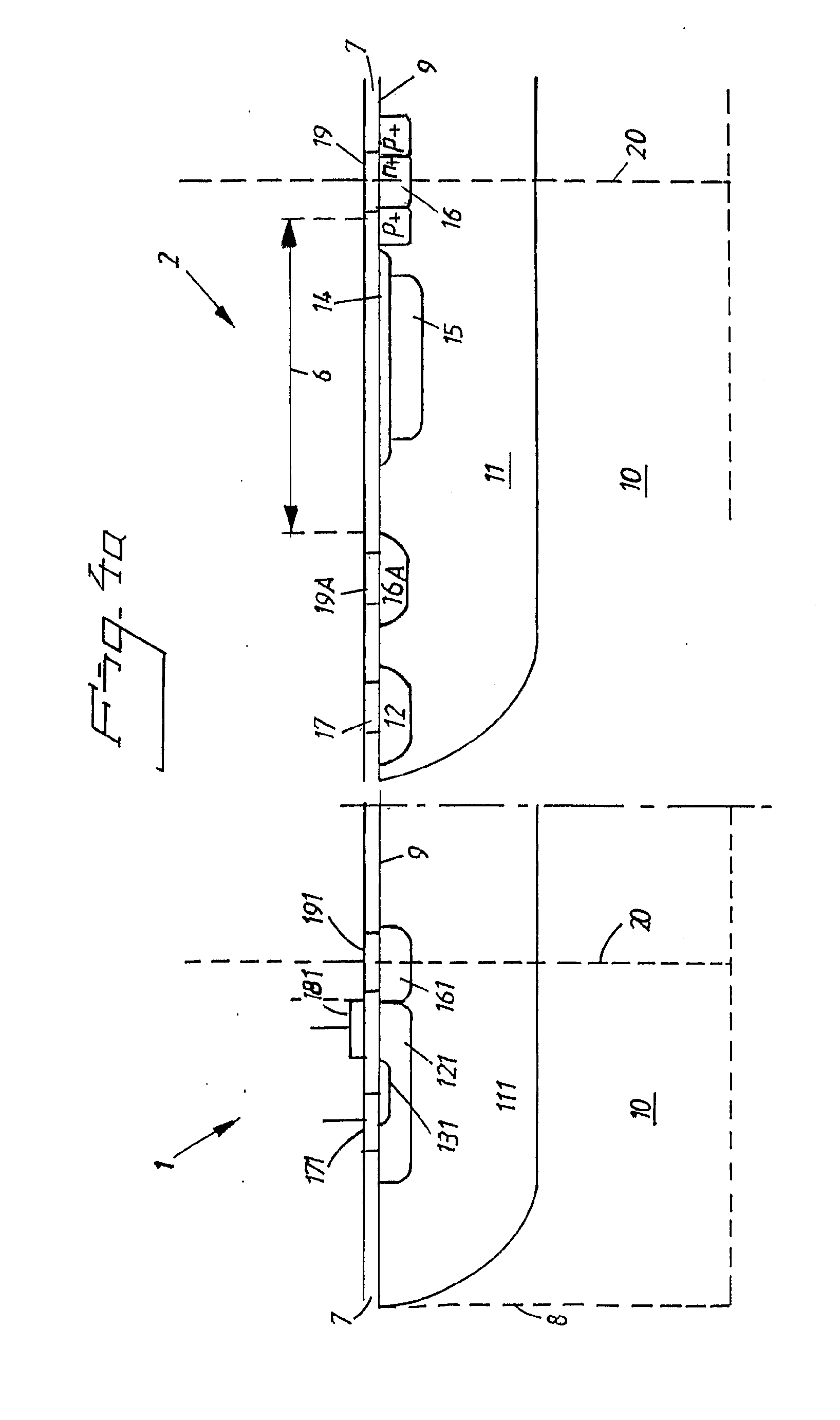
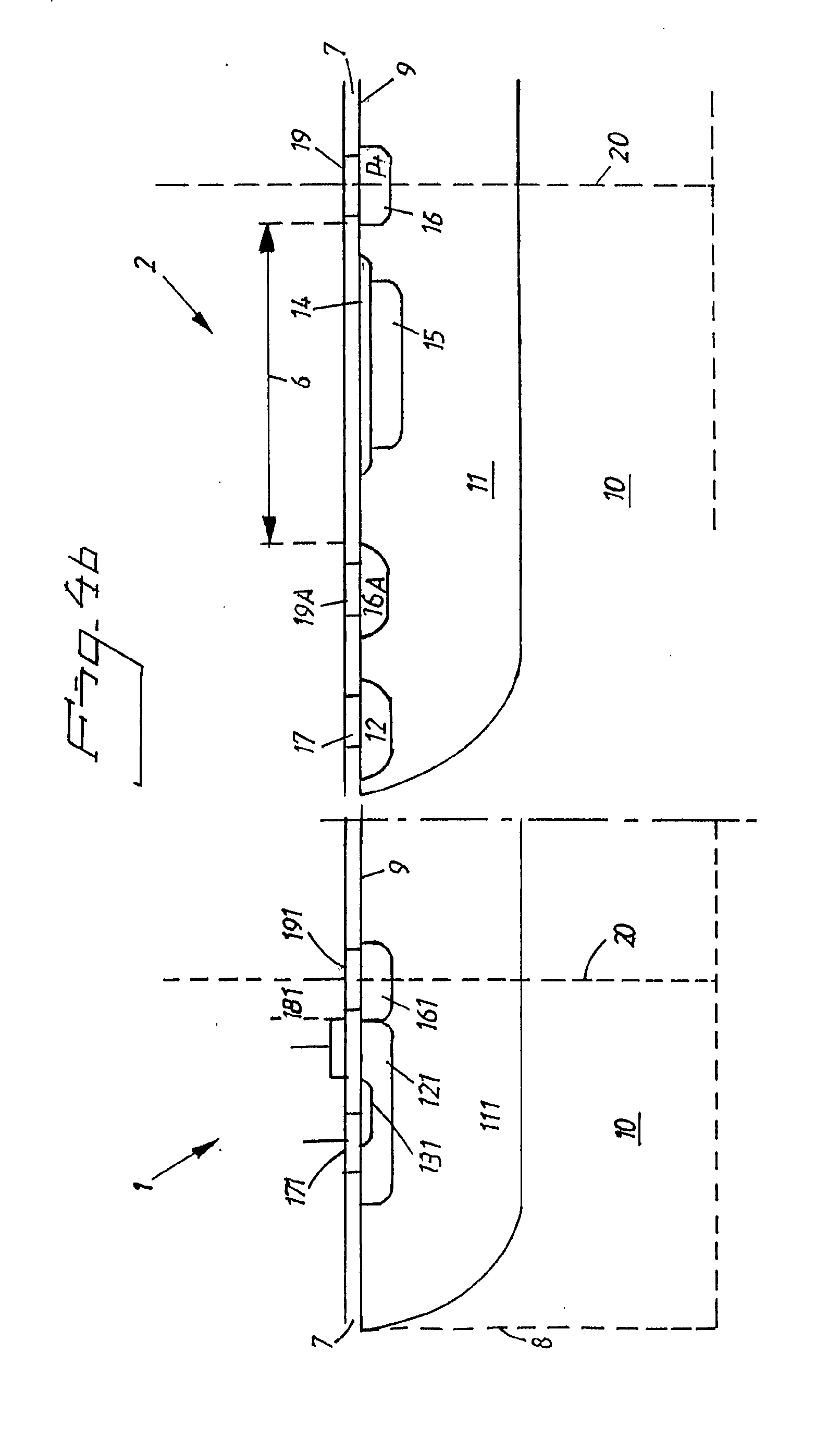
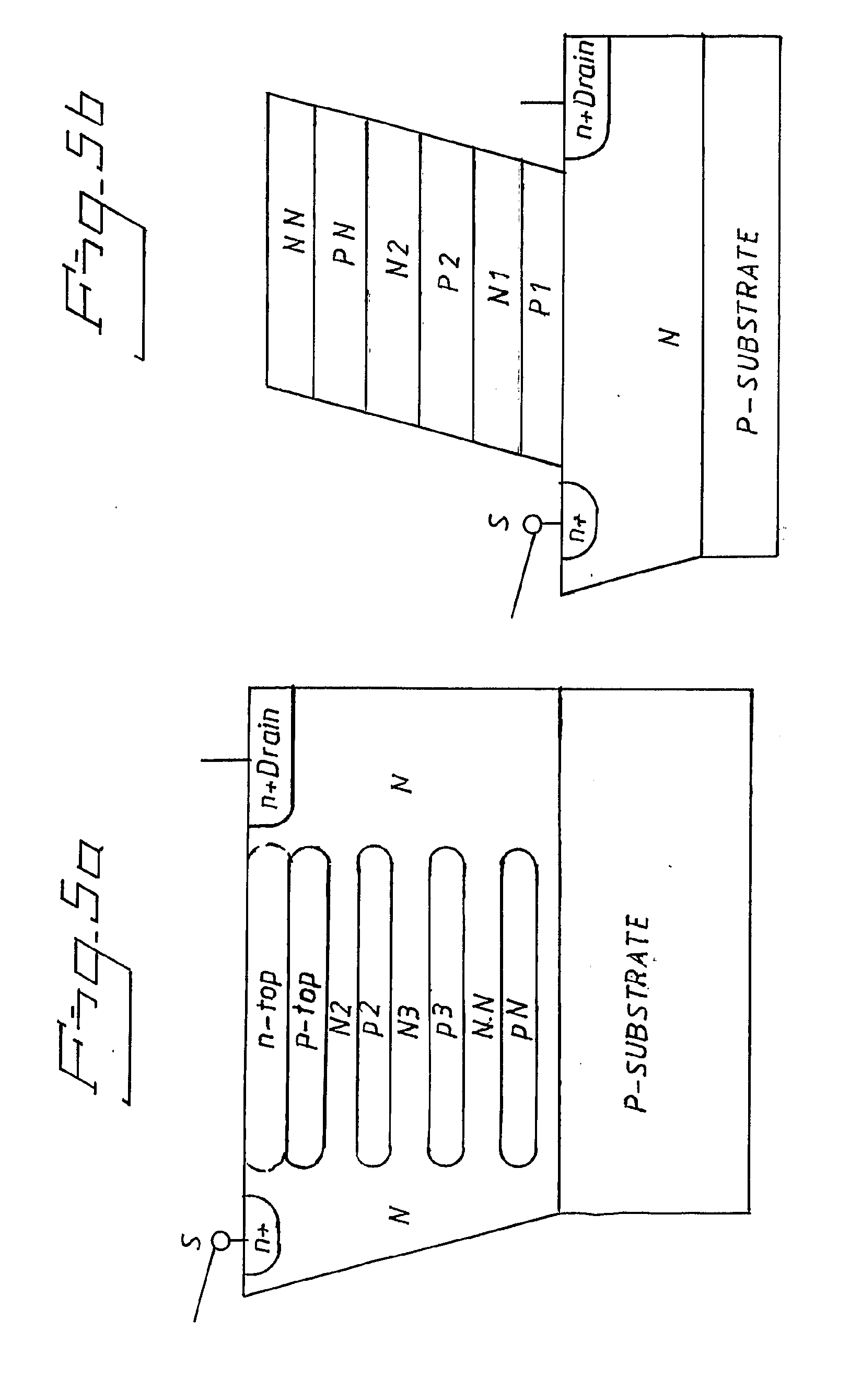
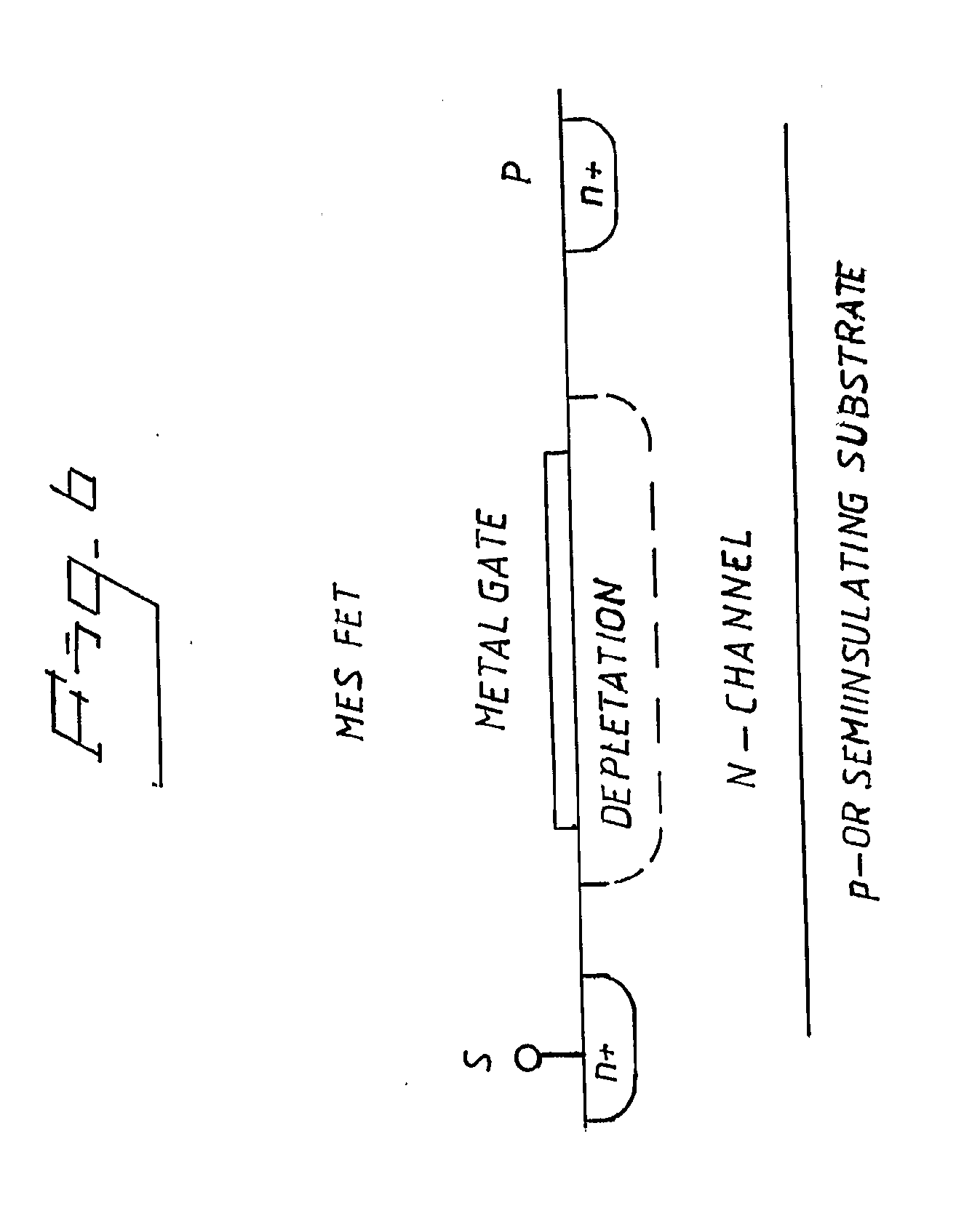
| United States Patent Application | 20100327330 |
| Kind Code | A1 |
| Eklund; Klas-Hakan | December 30, 2010 |
SEMICONDUCTOR DEVICE WHEREIN A FIRST INSULATED GATE FIELD EFFECT TRANSISTOR IS CONNECTED IN SERIES WITH A SECOND FIELD EFFECT TRANSISTOR
Abstract
A semiconductor device in which a first insulated gate field effect transistor (1) is connected in series with a second field effect transistor, FET, (2), wherein the second field effect transistor (2) has a heavily doped source region (19A) which is electrically connected to a heavily doped drain contact region (191) of the first insulated gate field effect transistor, and further that the breakthrough voltage of the first insulated gate field effect transistor (1) is higher than the pinch voltage, Vp, of the second field effect transistor (2).
| Inventors: | Eklund; Klas-Hakan; (Sollentuna, SE) |
| Correspondence Address: |
YOUNG & THOMPSON
209 Madison Street, Suite 500
Alexandria
VA
22314
US
|
| Family ID: | 41135815 |
| Appl. No.: | 12/667088 |
| Filed: | April 3, 2009 |
| PCT Filed: | April 3, 2009 |
| PCT NO: | PCT/SE09/50350 |
| 371 Date: | March 31, 2010 |
| Current U.S. Class: | 257/262 ; 257/E27.059 |
| Current CPC Class: | H01L 29/7393 20130101; H01L 29/861 20130101; H01L 29/808 20130101; H01L 27/085 20130101; H01L 29/0834 20130101 |
| Class at Publication: | 257/262 ; 257/E27.059 |
| International Class: | H01L 27/085 20060101 H01L027/085 |
Foreign Application Data
| Date | Code | Application Number |
|---|---|---|
| Apr 4, 2008 | SE | 0800764-3 |
Claims
1. A semiconductor device in which a first insulated gate field effect transistor (1) is connected in series with a second field effect transistor, FET, (2), characterised in that the second field effect transistor (2) has a heavily doped source region (19A) which is electrically connected to a heavily doped drain contact region (191) of the first insulated gate field effect transistor, and further that the breakthrough voltage of the first insulated gate field effect transistor (1) is higher than the pinch voltage, Vp, of the second field effect transistor (2).
2. A device according to claim 1, characterised in that the second field effect transistor comprises several field effect transistors in parallel with a common heavily doped source contact region (19a).
3. A device according to claim 1, characterised in that the width W of the first insulated gate field effect transistor (1) is at least 2 times larger than the width W of the second field effect transistor (2).
4. A device according to claim 1, characterised in that the second field effect transistor (2) is a junction field effect transistor, JFET.
5. A device according to claim 1, characterised in that the second field effect transistor (2) is an insulated gate field transistor.
6. A device according to claim 1, characterised in that the second field effect transistor (2) with modified drain contact region connected in series with the first insulated gate field effect transistor (1) is an insulated gate bipolar transistor, IGBT.
7. A device according to claim 1, characterised in that the first insulated gate field effect transistor (1) and the second field effect transistor (2) are arranged on different substrates.
8. A device according to claim 1, characterised in that the first insulated gate field effect transistor (1) and the second field effect transistor (2) are arranged on a common substrate.
9. A device according to claim 8, characterised in that the first insulated gate field effect transistor (1) and the second field effect transistor (2) are merged together, and that the drain contact region (191) for the first insulated gate field effect transistor (1) is the same as source contact region (19A) for the second transistor device (2).
10. A device according to claim 1, characterised in that both the first insulated gate field effect transistor (1) and the second field effect transistor (2) are incorporated in the surface region of the substrate (10).
11. A device according to claim 4, characterised in that the second field effect transistor comprises a number of Ntop and Ptop layers arranged vertically to make up channels and gates of paralleled junction field effect transistors with a common source region.
12. A device according to claim 4, characterised in that the second field effect transistor comprises a number of Ntop and Ptop layers arranged horizontally to make up channels and gates of paralleled junction field effect transistors with a common source region.
13. A device according to claim 1, characterised in that the second field effect transistor (2) is a combination of one or more junction field transistors and one or more insulated gate field transistors, all with a common source contact diffusion.
Description
[0001] The present invention relates to a novel semiconductor device wherein a first insulated gate field effect transistor is connected in series with a second field effect transistor.
[0002] A high voltage and high current LDMOS transistor is a very common device used in smart power applications.
[0003] For such a device the importance of gate overlap over drift region for high current and low on-resistance has been presented by Sel Colak, "Effects of drift region parameters on the static properties of power LDMOS", IEEE transaction on electron devices, vol. ED-28 No. 12, pp 1455-1466 (Dec. 1981). Even if the gate overlap is very positive for having a high current and low on-resistance it causes a very high input-capacitance which varies a lot with gate voltage and limits the high frequency performance.
[0004] U.S. Pat. No. 5,396,085 by Baliga presents a series combination of a silicon MOSFET with a JFET, particularly a silicon carbide JFET where two discrete devices are bonded together to form a composite substrate of silicon and silicon carbide.
[0005] A problem with the above US patent is that it is difficult to integrate in a combined component on a substrate together with other components as it requires a high voltage and therefore an efficient cooling. It can not be used and combined with low voltage control functions.
[0006] It is therefore an object of the present invention to provide a novel semiconductor device wherein a first insulated gate field effect transistor is connected in series with a second field effect transistor which avoids the drawbacks of the above known components, and that allows a higher current, lower on-resistance and that requires lower power for functioning within a given area.
[0007] This object with the invention is obtained by means of a transistor of the above type, wherein according to the invention the second field effect transistor has a heavily doped source region which is electrically connected to a heavily doped drain contact region of the first insulated gate field effect transistor, and further that the breakthrough voltage of the first insulated gate field effect transistor is higher than the pinch voltage, Vp, of the second field effect transistor.
[0008] The invention will now be described in further detail with the help of the enclosed drawings, in which
[0009] FIG. 1 shows a schematic view of a principal implementation of a high voltage LDMOS transistor,
[0010] FIG. 2 shows the principle of the connection of a MOS transistor and a JFET transistor coupled in series in accordance with the present invention,
[0011] FIG. 3 shows a non-limiting embodiment of the invention,
[0012] FIGS. 4a and 4b show two alternative embodiments of the invention, as variants to the one shown in FIG. 3,
[0013] FIGS. 5a and 5b show two alternative JFET transistors corresponding to the JFET transistor shown on the right hand side of FIG. 2, and
[0014] FIG. 6 shows an alternative where the JFET has been replaced by a MESFET.
[0015] In FIG. 1 is shown a typical principal implementation of a high voltage LDMOS transistor according to U.S. Pat. No. 5,146,298 by the same inventor as the present application. This component can be seen as an internal coupling in series of a MOS transistor and a JFET. The JFET source, Sj, is also the drain, Dm, of the internal MOS transistor. The gate material is made of polysilicon which in accordance with the figure overlaps the channel area. The JFET is decisive for the maximum current. To obtain a high current it is important that the source Sj resistance is small. At an overlapping gate a positive voltage on the gate will increase the concentration of charge carriers in the source Sj, and thereby reduce the resistance in the area, which results in an increased current. The maximum current is deeply dependent on how large the overlap is. For an overlap of 1.0 .mu.m a current of 200 mA is obtained, and which will be reduced to about 140 mA if the overlap is only 0.1 .mu.m.
[0016] In FIG. 2 is shown the principal coupling of a MOS in series with a JFET. The source resistance in the JFET is made very low with a n+ diffusion and similarly the drain n+ diffusion for the MOS transistor. If the compound component shall be able to resist a high voltage it is necessary that the pinch voltage, Vp, of the JFET is lower than the breakthrough voltage, Vbr, of the MOS component. The JFET is pinched, i.e. is cut down, at a voltage that is lower than the breakthrough voltage of the MOS transistor. For the same width, W, of the components the current is increased to 250 mA. If on the other hand the width, W, of the MOS transistor is made 3-4 times greater the current is increased to more than 350 mA. If the MOS transistor is made wider, only 2-3V is necessary on the gate to drive the transistor, compared to 10-15V if the transistors have the same width. This means that the component can be driven at the same voltage as the control logics without the necessity of an additional voltage source, which is a big advantage, and also that the power necessary to drive the component can be reduced with a factor 4-5.
[0017] E.g. when the width of the insulated gate field effect transistor is made 4 times wider than the width of the JFET the input capacitance of the combined device will be 4 times larger and the gate voltage will be reduced from 12V to 3V. The energy stored in the input capacitor is proportional to CV.sup.2, hence the input power for switching will be reduced by a factor of 4.
[0018] Further, as the distance between the drain of the JFET and the gate of the insulated gate field effect transistor is increased the capacitance between the drain and the gate is reduced which is very important for high frequency performance.
[0019] As the JFET will be pinched off well before breakthrough voltage can occur in the insulated gate field effect transistor, this will be shielded from higher voltages.
[0020] This will dramatically reduce the electric field close to the gate of the insulated gate field effect transistor and improve reliability. A high field close to the gate is a major reliability concern in present LDMOS devices.
[0021] In FIG. 3 is shown a preferred embodiment of a transistor arrangement according to the invention, showing a diagrammatic view of a MOS transistor 1, as the first insulated gate field effect transistor, in series with a junction field effect transistor 2, as the second field effect transistor, on the same die in accordance with a preferred embodiment of the present invention.
[0022] FIG. 3 on the right hand side shows a cross-sectional view of a lateral JFET 2 in series with a MOS transistor 1, on the left hand side, formed on the same semiconductor die.
[0023] A substrate 10 of a material of a first conductivity type consists of an epitaxial layer with a thickness of around 12 .mu.m and a resistivity of 10-15 ohmcm on top of a highly doped substrate with a thickness of around 500 .mu.m. A pocket 11 for the JFET of material of second conductivity type is, for example, n-type material doped at 5*10.sup.12 atoms per cm.sup.2. Pocket 11 extends to a depth of around 4 .mu.m below a surface 9 of die 8. The doping levels and dimensions given here and below are for a device with breakdown voltage of approximately 200 V. A similar pocket 111 is formed for the MOS transistor on the left hand side in FIG. 3.
[0024] Within or partly within pocket 11, and pocket 111 a body region 12 and 121 of first conductivity type, for example p-type material, is doped at between 10.sup.17 and 10.sup.20 atoms per cm.sup.3. Body region 12 typically extends to a depth of 1 .mu.m or less below surface 9 of die 8. Within body region for the MOS transistor 121, a source region 131 of second conductivity type is, for example n+ type material, doped at between 10.sup.18 and 10.sup.20 atoms per cm.sup.3. Source region 131, extends for example 0.4 .mu.m or less below the surface 9 of the die 8. Body regions 12 and 121 may be electrically connected to the substrate 10 by extending the body regions 12 and 121 outside the pocket regions 11 and 111.
[0025] A drain contact region 16 and 161 of second conductivity type, for example n+ type material, is doped at between 10.sup.18 and 10.sup.20 atoms per cm.sup.3. Drain contact region 16 and 161 extends, for example, 0.4 .mu.m or less below the surface 9 of the die 8. A source contact region for the JFET 16A similar to the drain contact region 16 is placed between the body region 12 and the drain contact region 16.
[0026] A source contact 171 for the MOS transistor, left hand side in FIG. 3, is placed on the surface 9 in electrical contact with the body region 121 and a source contact region portion of source region 131. A drain contact 191 for the MOS transistor is placed on the surface 9 in contact with drain contact region 161. An insulating layer 7 is placed on the surface 9 of the die 8.
[0027] A gate contact 181 is placed on the insulating layer 7 over a to channel region portion of the body region 121, as shown. A body contact 17 is placed on the surface 9 in contact with the body region 12. A drain contact 19 is placed on the surface 9 in contact with the drain contact region 16.
[0028] A source contact 19A is placed on the surface 9 in contact with source the contact diffusion 16A. Between the source contact region 16A for the JFET, right hand side of FIG. 3, and the drain contact region 16 is a region 14 of second conductivity type. The region 14, for example n-type material, is doped at 2-4*10.sup.12 atoms per cm.sup.2. The region 14 extends downward from the surface 9 to a depth, for example 0.4 .mu.m. Located below the region 14 is a region 15 of the first conductivity type. The region 15, for example p-type material, is doped at 5*10.sup.12 atoms per cm.sup.2. The region 15 extends from the surface 9 downward to a depth of, for example, 1 .mu.m. The region 15 is connected to ground at the surface 9 in a plane not shown in FIG. 3. A distance 6 between the edge of the source contact region 16A and an edge of the drain contact region 16 is, for example, 6 .mu.m. A symmetry line 20 is used for placing a second half of the transistor in a mirror image to the first half shown in FIG. 3.
[0029] The drain contact 191 of the MOS transistor, on the left hand side in FIG. 3, will be electrically connected to the source contact 19A of the JFET, on the right hand side of FIG. 3, and thus constitute a MOS transistor in series with a JFET.
[0030] A three terminal switching device is obtained where the source contact is 171, gate contact 181 and drain contact 19.
[0031] In another embodiment, if the drain n+ contact area 16 for the JFET in FIG. 3 is surrounded by p+ contact areas which are electrically connected to the n+ are or the n+ area is simply replaced by a p+ area, as shown in FIGS. 4a and 4b, respectively, two different IGBT transistors can be easily implemented.
[0032] Besides higher current capability these devices have the same performance advantages as the compound advantages described earlier.
[0033] Further these IGBT devices are completely immune from latch up which is a major concern in all IGBT devices.
[0034] The bipolar action will take place in device 2 as shown in FIG. 3. In device 2 there is no pnpn structure. The killing structure 121 (p) under 131 (n) has been moved out to device 1.
[0035] The JFET 2 in FIG. 3 is actually a parallel connection of a single sided JFET, channel layer 14 and gate layer 15, and a double sided JFET, channel layer 11 and gate layers 15 and 10.
[0036] In FIG. 5a is schematically shown how the second field effect transistor can be composed of a number of Ntop and Ptop layers arranged vertically to make up channels and gates of paralleled junction field transistors with a common source region. Similarly FIG. 5b shows schematically how the second field effect transistor can be composed of a number of Ntop and Ptop layers arranged horizontally to make up channels and gates of paralleled junction field transistors with a common source region.
[0037] As indicated in FIG. 2 the JFET can also be implemented in a SOI approach, where layer 10 has been replaced by an oxide layer. In this approach the JFET is a parallel connection of two single sided JFETs but the channel region 11 will also be affected from the bottom oxide layer as this will form an additional insulated gate transistor in parallel with the two JFETs.
[0038] The JFET in FIG. 2 could also be replaced by a MESFET, as shown in FIG. 6. The metal is earthed and therefore the p-layer will be depleted.
* * * * *
D00000

D00001

D00002

D00003

D00004

D00005

D00006

D00007

XML
uspto.report is an independent third-party trademark research tool that is not affiliated, endorsed, or sponsored by the United States Patent and Trademark Office (USPTO) or any other governmental organization. The information provided by uspto.report is based on publicly available data at the time of writing and is intended for informational purposes only.
While we strive to provide accurate and up-to-date information, we do not guarantee the accuracy, completeness, reliability, or suitability of the information displayed on this site. The use of this site is at your own risk. Any reliance you place on such information is therefore strictly at your own risk.
All official trademark data, including owner information, should be verified by visiting the official USPTO website at www.uspto.gov. This site is not intended to replace professional legal advice and should not be used as a substitute for consulting with a legal professional who is knowledgeable about trademark law.